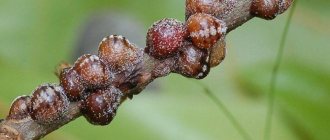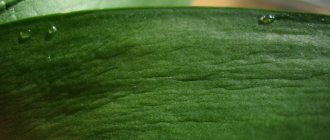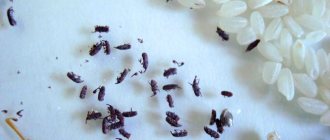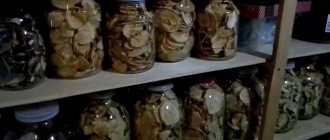Females
Females lack wings, antennae and legs and are distinguished by the presence of a round scutellum. This Californian scale insect has a size of up to 2 mm. The chitinous shell acquires a shade similar to the color of the host plant. In different crops, the size, length and body shape of females may vary. Individuals of this category can be recognized by their characteristic yellowish skin with a white border located in the center of the shield.
Males
The body of males has an oval, elongated shape.
The length of the shield is from 0.6 to 1 mm. Color - from yellowish and black to light gray. A mature male California scale insect contains a dark transverse stripe on its carapace. Unlike females, males have well-developed wings, legs and antennae.
They are distinguished by the presence of pronounced purple eyes. In some regions there are males lacking wings.
How to recognize a pest
There are a large number of species of scale insects. In our area the most common are:
- California scale insect;
- comma scale insect;
- acacia false scale;
- plum false scale.
All these species are suckers, causing harm on which they live.
The main feature of all species is the presence of a protective shield made from the remains of larval scales, connected to each other by insect secretions. This shell can easily be mistaken for natural irregularities in the bark. This camouflage makes it very difficult to detect pests.
While the larvae are still small, they move at high speed, and it is quite easy to detect them by visual inspection.
In later stages, the insect becomes more noticeable due to the increase in its shell. They can be seen with the naked eye - their shape resembles whitish spots on the leaves and at the base of the branches.
Larvae
There are several forms of California scale insect larvae:
- The vagrant is a newly hatched individual. It has an oblong-oval body shape, the length of which ranges from 0.2 to 0.3 mm. It has legs, eyes, and a well-developed mouthparts, the size of which can exceed the length of the body.
- Nymph is a transitional stage of the larva during which the chitinous shield is formed. The body takes on an oval shape. During this period of development, the Californian scale insect changes color from gray to dark black.
Biological characteristics of the pest
There are more than 2,400 species in the scale insect family. A characteristic feature of the pests is the presence of a waxy shield-like shell, which predetermined the common name. The leader in harmfulness belongs to the Californian scale insect, which causes damage to both large agricultural farms and owners of personal plots.
How to recognize a garden pest
Most often, the Californian scale insect lives on apples, pears, and plum trees. He does not ignore cherries, apricots, cherries, acacias, willows, peaches, and rose bushes.
The adult insect is characterized by its miniature size and protective color. Pests have pronounced sexual dimorphism:
- In the female, the head and chest are fused into a single whole - the cephalothorax. Females are deprived of wings, antennae, legs and even eyes. The scutellum is almost round, its size reaches 2 mm in diameter. The color corresponds to the plant on which the Californian scale insect lives, and also depends on the age of the individual. The center of the shield is decorated with 2 rusty-brown skins bordered by a narrow white stripe. The body itself is bright lemon color, its length does not exceed 1.3 mm.
- Males are smaller than females, but have a well-developed pair of wings, antennae, legs and eyes of a rich purple-scarlet color. There is no oral organ. Males grow no more than 0.85 mm. Body yellow or brown. The shield is painted in light gray, yellow, brown tones, with a dark transverse stripe running down the center. The length of the carapace is 1 mm, and the width is half that.
The first instar larvae are called strays. They are distinguished by well-developed legs and the presence of eyes. Dimensions 0.2-0.3 mm. They can only be noticed due to their bright yellow or orange color. Interestingly, the mouthparts of young individuals are twice the length of their body.
Larvae of the second and subsequent instars acquire the characteristic features of adults. In males, the shield becomes oval and oblong in shape, the body is clearly divided into the chest and head, and wings appear. In females, the eyes and legs are reduced.
Nuances of life
In the photo, the California scale insect looks like growths on the bark. Single individuals are extremely rare; they mainly live in colonies in which insects of different ages. They spend the winter in the first instar larval stage under the bark of trees.
On a note! Californian scale insects are resistant to low temperatures. Death occurs only in severe winters, when the thermometer drops below minus 35°C.
As the plants awaken, scale insects also awaken. The larvae begin to feed intensively and increase in size. The scutum becomes small and the first molt occurs, after which sexual characteristics appear. The population is dominated by females, the number of males ranges from 10 to 15%. Further development occurs according to two scenarios:
- One part of the larvae enters diapause. The shell of such individuals is black and they go into hibernation until next year.
- Other young individuals continue their development. After the completion of the molt, the males fly out from under the scutes and perform their direct duties - they fertilize the females. They do not live long, since they lack an oral organ and exist due to the accumulated nutrients during the larval stage. They die off 3-4 days after the start of summer. Some males have a lifespan of several hours. Mating usually occurs at the beginning of the second ten days of May.
California scale insects are viviparous species. Fertilized females spend 2 months giving birth to strays. Such a long period of reproduction of offspring greatly complicates the fight against the pest. Vagrants are very active and carefully choose their habitat. Without food, the younger generation can live 7 days. They can crawl around a tree for several days until they find a comfortable environment for themselves: a well-lit place near the top of the tree, on the trunk, or skeletal branches.
On a note! The California scale insect does not establish a large colony on young shoots.
Having decided on its habitat, the tramp pierces the bark with the help of sharp bristles of the oral apparatus. Having attached itself to the plant, it secretes wax-like threads that intertwine and form a white shield covering the top of the larva. After a week it turns gray. With the onset of this moment, the stray molts and begins a new phase of its development.
What harm does scale insects cause?
The Californian scale insect is absolutely unpretentious in nutrition. Rapid population growth and active reproduction are also facilitated by the absence of natural enemies. That is why the insect has taken root well in American and European gardens.
Scale insects are located in numerous colonies on the branches, fruits and leaves of cultivated plants. During development, the larvae suck the sap from the trees, which leads to cracking and death of the bark. Depletion of plants impedes their growth, causes deformation and reduction of fruits.
Trees affected by large colonies of scale insects often lose their ability to produce crops, since the main reserves of nutrients are used to restore the structure of leaves and bark.
The fight against the Californian scale insect is extremely important, since plants affected by the pest die even in mild frosts. Actions aimed at protecting fruit trees are taken in early March, when buds have not yet formed on the plants.
What does the affected plant look like?
The first sign that your plant is infested with scale insects will be the presence of a sticky, syrup-like coating on the leaves. This secretion is called honeydew or honeydew. They are formed as a result of the vital activity of sucking insect pests. In these secretions, sooty fungus actively develops, which causes serious damage to plants.
Having examined your “green friend”, you will also notice gray-brown or off-white plaques on the trunk, branches, and lower parts of the leaves. These are females and adult larvae that suck the sap from the plant.
Honeydew or honeydew
For example, the Californian scale insect (like many other types of scale insects) in the first year after infection leads to the growth of new tissue in damaged areas. Therefore, tuberosity and unevenness of the bark are formed. The affected leaves first turn red, then become deformed and fall off. In the second year of infection, large colonies of scale insects are already formed, the growth and development of the plant slows down, and some branches die. In the third year, massive drying out of branches and leaves begins, and the bark cracks.
And the mulberry scale, sucking out the juice, weakens the plant, the fruits become smaller, the yield decreases, they lose their presentation, and spots appear.
Sometimes the clusters of scale insects are so large that they can be mistaken for growths on the bark. Young plants suffer the most, since they have little strength to fight the pest, and they often die.
Unfortunately, it is not always possible to immediately notice scale insect plaques, and when the infestation becomes noticeable, it is already quite difficult to fight.
Basic description of the pest May beetles, also known as May beetles, are insects of the order Coleoptera, family...
Pest development cycle
Californian scale insect larvae overwinter on the bark of branches and trunks, hiding from external influences under durable, well-insulated chitinous shells.
With the arrival of warmth during the period of sap flow, insects awaken and begin to feed. After several molts over 20-22 days, the larvae complete their transformation into adults. Males become active in breeding by mid-May. Their number is about 10% of the total population. Each female gives birth to up to 100 larvae over several months. The latter crawl in huge quantities along the branches of trees, stick to the bark and become covered with scutes, which act as natural protection for them.
Having dropped the shield, the males mate and then die. At the beginning of August, females cling to plants, continuing to consume nutrients, and with the onset of cold weather they go into hibernation, becoming covered with a more durable shield.
Pest control in various ways
Insects have a shield that protects the scale insect from various influences. But a set of measures aimed at defeating the pest can be effective.
Among them:
- mechanical removal of a small settlement using a swab soaked in alcohol;
- folk methods that work on young individuals. These are different infusions and decoctions;
- biological, use of entomophages and fungicides;
- chemical, strong insecticides.
But when using any methods of control, it is necessary to take into account the life cycle of the scale insect, because at a certain moment, when it is covered with a shell, almost all actions will be ineffective.
Signs of plant damage by scale insects
The main sign of the appearance of the pest is the formation of light and brownish round scales on the leaves of trees.
The latter are quite difficult to separate from the surface. Such manifestations indicate the presence of adult California scale insects. A sign of the spread of pest larvae is the loss of natural shine by tree bark.
Infection of plants by developing insects also leads to the appearance of sap drips on branches and trunks and gluing of leaves. Brown and red spots form on damaged areas of wood. In the absence of actions aimed at destroying the insect larvae, these areas subsequently die off, which leads to the gradual drying out of the plant.
Warning before destroying scale insects
Before you destroy the scale insect, take care of your own safety. If you choose to use chemical sprays, you should take care to protect yourself with covered clothing and protective equipment such as gloves, safety glasses, and a mask (or respirator).
When using any chemicals or insecticides, be sure to read the label - this is very important for your health and the environment. After applying any chemicals or pesticides, be sure to thoroughly wash all exposed skin with soap and water. It is better to clean and dry clothes outside the home, for example in the garage
It is better to clean and dry clothes outside the home, for example in the garage
After applying any chemicals or pesticides, be sure to thoroughly wash all exposed skin with soap and water. It is better to clean and dry clothes outside the home, for example in the garage.
California scale insect: control measures
The pest is destroyed by spraying trees.
They resort to the procedure when the air temperature at night is not lower than 4 ° C. Otherwise, the liquid in the working composition may freeze. What chemical kills California scale insects? The trunks and crowns of trees are sprayed with neonictionides, pyrethroids, and products that contain organophosphorus compounds. The treatment is carried out by washing the plants. In other words, the trees are completely covered in liquid chemical composition. Only this approach allows us to count on the complete destruction of the larvae and the creation of conditions that prevent the reproduction of adults.
When considering how to deal with California scale insects, it is worth noting such an effective remedy as mineral oil. The result of treating cultivated plants with this solution is the formation of a thin, airtight film on the surface of the plants. Enveloping trees with this product causes rapid death of scale insect larvae due to lack of oxygen. Mineral oils for treating trees are safe for humans. They can be used even if there are ripe fruits on the branches.
A prerequisite for preparing trees for chemical treatment is the preliminary removal of dead bark and dry branches, leaves, root shoots, and thinning of the crowns. The resulting waste is collected in one place and then burned.
Basic methods of struggle
The insect has a protective shell, which makes the process of fighting it labor-intensive. If scale insects have managed to multiply, then you cannot do without the use of chemical insecticides. The plant is sprayed with them in 3-4 procedures until the scale insects are completely destroyed. When there are very few pests or the crop is ripening, which does not allow the use of toxic substances, then folk or biological remedies can be used.
To make the fight easier or protect your garden from scale insects, you need to keep it in order:
- trim and thin out the crown as necessary;
- clean the trunk of dead particles of bark, moss and lichen;
- cut off infected shoots and burn them;
- remove growth in the root zone.
Each new plant brought to the site must be carefully examined and quarantined. The seedling should not be placed in the garden until it is completely free of pests.
Chemicals
Chemical insecticides show very good results in the fight against scale insects. They contain toxic substances that cause the death of the pest. But to prevent toxic compounds from accumulating in plum fruits, treatments must be carried out either long before ripening or after harvesting. The exact timing is indicated in the instructions for each drug.
“Working” insecticides against scale insects:
- “Drug 30 (B)” is used in early spring, before the buds appear. It will destroy the larvae overwintering in the bark.
- "Aktara" is a systemic insecticide that is used both for spraying and for root watering of young plum seedlings.
- "Actellik" containing organophosphorus compounds. An effective but toxic product, which is not recommended for use near the home.
- "Biotlin."
- "Confidor Extra".
It is recommended to change insecticides so that scale insects do not develop immunity to them.
Folk remedies
The fight against scale insects on plums can also be carried out using folk remedies. But such methods will bring the desired result only if there are very few insects. There are no compounds that are poisonous to humans in recipes for treating fruit trees, and their use of folk remedies is safe for health. Here are some of them:
- A simple solution of 10 g of laundry soap shavings in 10 liters of water.
- 50 g of green soap diluted in 10 liters of water.
- 10 g of soda ash per 10 liters of water.
- An infusion of “caustic” plants: garlic, walnut, shag and wormwood.
- Emulsion of machine oil and soap solution. The optimal proportion is 1:10. Can be used once per decade.
Such products are used for spraying plums. Treatments, as when using chemicals, should be carried out at intervals of 7–10 days.
Biological
Biological studies have identified natural enemies of scale insects, which are now used to combat the pest:
- Ladybugs, and especially the reniform and two-spotted chylocorus, reduce the number of scale insects by 50–70% if released into the garden in May. One individual can eat approximately 700 larvae.
- The small parasite Prospaltella perniciosi is also effective against the pest.
- To destroy scale insects, you can use popular biological products containing nematodes or fungi: Aversectin, Avertin and Nemabact.
They do not contain toxic substances, so the crop will be safe after their use. Biological products do not harm the plum itself.
When choosing a method to combat scale insects on drains, it is necessary to correctly assess the scale of the infestation and the real threat. For better results, you can combine chemical, folk and biological drugs with each other
It is important to follow the instructions and not forget about regularity: if you skip one treatment, you will have to start all over again











